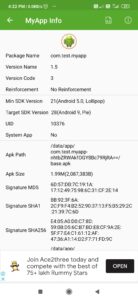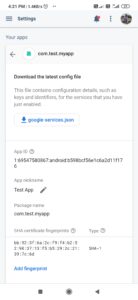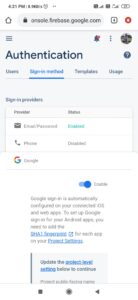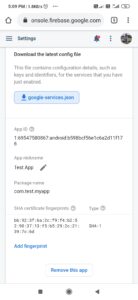 This tutorial shows a sample project using Google Sign in in AIDE.
This tutorial shows a sample project using Google Sign in in AIDE.
Step 1: Create a new project in AIDE with name MyApp and package name com.test.myapp.
Step 2: Create a new project in Firebase console. To this project add an android app with package name com.test.myapp.
Step 3: In AIDE, run the project and sign using a debug or release key.
Step 4: Using Dev tools app find the SHA-1 of the installed app.

Step 5: Paste the SHA-1 in Firebase console project settings.

Step 6: In Firebase Authentication — Sign-in method, enable Google.

Step 7: Download google-services.json file.

Step 8: Put the google-services.json file in app/ folder of your project.

Step 9: In app/build.gradle use following code.
apply plugin: 'com.android.application'
android {
useLibrary 'org.apache.http.legacy'
compileSdkVersion 28
defaultConfig {
applicationId "com.test.myapp"
minSdkVersion 21
targetSdkVersion 28
versionCode 3
versionName "1.5"
multiDexEnabled true
}
buildTypes {
release {
minifyEnabled false
proguardFiles getDefaultProguardFile('proguard-android.txt'), 'proguard-rules.pro'
}
}
}
dependencies {
implementation 'de.hdodenhof:circleimageview:3.1.0'
implementation 'com.github.bumptech.glide:glide:3.7.0'
compile 'android.arch.core:common:+'
api 'com.google.android.gms:play-services-auth:16.+'
compile fileTree(dir: 'libs', include: ['*.jar'])
implementation 'com.google.firebase:firebase-auth:17.0.0'
implementation 'com.google.firebase:firebase-database:17.0.0'
implementation 'com.google.firebase:firebase-storage:17.0.0'
}
apply plugin: 'com.google.gms.google-services'
Step 10: In AndroidManifest.xml add following code.
<?xml version="1.0" encoding="utf-8"?>
<manifest xmlns:android="http://schemas.android.com/apk/res/android"
package="com.test.myapp" >
<uses-permission android:name="android.permission.INTERNET" />
<uses-permission android:name="android.permission.ACCESS_NETWORK_STATE" />
<application
android:allowBackup="true"
android:icon="@drawable/ic_launcher"
android:label="@string/app_name"
android:theme="@style/AppTheme"
android:resizeableActivity = "true">
<activity
android:name=".MainActivity"
android:label="@string/app_name" >
<intent-filter>
<action android:name="android.intent.action.MAIN" />
<category android:name="android.intent.category.LAUNCHER" />
</intent-filter>
</activity>
<activity
android:name=".HomeActivity"
/>
<meta-data
android:name="com.google.android.gms.version"
android:value="@integer/google_play_services_version"/>
<!-- Use your package name in the 'android:authorities' in provider code below-->
<provider
android:name="com.google.firebase.provider.FirebaseInitProvider"
android:authorities="com.test.myapp.firebaseinitprovider"
android:exported="false"
android:initOrder="100"/>
<service
android:name="com.google.firebase.components.ComponentDiscoveryService"
android:exported="false">
<meta-data
android:name="com.google.firebase.components:com.google.firebase.auth.FirebaseAuthRegistrar"
android:value="com.google.firebase.components.ComponentRegistrar"/>
<meta-data
android:name="com.google.firebase.components:com.google.firebase.database.DatabaseRegistrar"
android:value="com.google.firebase.components.ComponentRegistrar"/>
<meta-data
android:name="com.google.firebase.components:com.google.firebase.storage.StorageRegistrar"
android:value="com.google.firebase.components.ComponentRegistrar"/>
</service>
<uses-library
android:name="org.apache.http.legacy"
android:required="false"/>
</application>
</manifest>
Step 11: In app/src/main/res/values/ folder add a new XML file secrets.xml. In secrets.xml, add following code.

<resources> <integer name="google_play_services_version">12451000</integer> </resources>
Step 12: In main.xml, add following code.
<?xml version="1.0" encoding="utf-8"?> <LinearLayout xmlns:android="http://schemas.android.com/apk/res/android" android:layout_width="match_parent" android:layout_height="match_parent" android:padding="24dp" android:background="#FFFFFF" android:gravity="center_vertical|center_horizontal" android:orientation="vertical"> <de.hdodenhof.circleimageview.CircleImageView xmlns:app="http://schemas.android.com/apk/res-auto" android:id="@+id/imageview1" android:layout_width="100dp" android:layout_height="100dp" android:src="@drawable/ic_launcher" app:civ_border_width="1dp" app:civ_border_color="#FF000000"/> <TextView android:layout_width="wrap_content" android:layout_height="wrap_content" android:text="WELCOME" android:layout_margin="10dp" android:textSize="30sp" android:textStyle="bold" android:textColor="#454072" android:elevation="10dp"/> <com.google.android.gms.common.SignInButton android:id="@+id/sign_in_button" android:layout_width="wrap_content" android:layout_height="wrap_content" android:layout_marginBottom="60dp" android:layout_marginTop="20dp"/> </LinearLayout>
Step 13: Create a new XML file home.xml. In home.xml, add following code.
<?xml version="1.0" encoding="utf-8"?> <LinearLayout xmlns:android="http://schemas.android.com/apk/res/android" android:layout_width="fill_parent" android:layout_height="fill_parent" android:orientation="vertical" android:gravity="center_vertical|center_horizontal"> <de.hdodenhof.circleimageview.CircleImageView xmlns:app="http://schemas.android.com/apk/res-auto" android:id="@+id/imageview_profile_pic" android:layout_width="100dp" android:layout_height="100dp" android:src="@drawable/ic_launcher" app:civ_border_width="1dp" app:civ_border_color="#FF000000"/> <TextView android:layout_width="wrap_content" android:layout_height="wrap_content" android:text="WELCOME" android:layout_margin="10dp" android:textSize="18sp" android:textStyle="bold" android:textColor="#454072" android:elevation="10dp" android:id="@+id/textview_name"/> <TextView android:layout_width="wrap_content" android:layout_height="wrap_content" android:text="You have successfully logged in." android:textAppearance="?android:attr/textAppearanceLarge" android:gravity="center_horizontal"/> <Button android:layout_width="wrap_content" style="?android:attr/buttonBarButtonStyle" android:layout_height="wrap_content" android:text="LOG OUT" android:id="@+id/button_logout"/> </LinearLayout>
Step 14: In MainActivity.java use following code.
package com.test.myapp;
import android.app.Activity;
import android.app.*;
import android.os.*;
import android.view.*;
import android.view.View.*;
import android.widget.*;
import android.content.*;
import java.util.*;
import java.text.*;
import com.google.android.gms.auth.api.signin.*;
import com.google.android.gms.common.*;
import com.google.android.gms.common.api.*;
import com.google.firebase.auth.*;
import com.google.android.gms.tasks.OnCompleteListener;
import com.google.android.gms.tasks.Task;
import android.support.annotation.NonNull;
public class MainActivity extends Activity {
public static final int RC_SIGN_IN = 1;
SignInButton signInButton;
public FirebaseAuth mAuth;
GoogleSignInClient mGoogleSignInClient;
private Intent i = new Intent();
@Override
protected void onCreate(Bundle _savedInstanceState) {
super.onCreate(_savedInstanceState);
setContentView(R.layout.main);
com.google.firebase.FirebaseApp.initializeApp(this);
mAuth = FirebaseAuth.getInstance();
GoogleSignInOptions googleSignInOptions = new GoogleSignInOptions.Builder(GoogleSignInOptions.DEFAULT_SIGN_IN)
.requestIdToken(getString(R.string.default_web_client_id))
.requestEmail()
.build();
mGoogleSignInClient = GoogleSignIn.getClient(this, googleSignInOptions);
initialize(_savedInstanceState);
}
private void initialize(Bundle _savedInstanceState) {
signInButton = findViewById(R.id.sign_in_button);
signInButton.setSize(SignInButton.SIZE_WIDE);
signInButton.setOnClickListener(new View.OnClickListener() {
@Override
public void onClick(View view) {
UserSignInMethod();
}
});
}
@Override
public void onStart() {
super.onStart();
FirebaseUser currentUser = mAuth.getCurrentUser();
if (currentUser != null) {
i.setClass(getApplicationContext(), HomeActivity.class);
startActivity(i);
finish();
}
}
public void UserSignInMethod(){
try{
Intent signInIntent = mGoogleSignInClient.getSignInIntent();
startActivityForResult(signInIntent, RC_SIGN_IN);
} catch (Exception e){
Toast.makeText(getApplicationContext(), e.toString(), Toast.LENGTH_LONG).show();
}
}
@Override
public void onActivityResult(int requestCode, int resultCode, Intent data) {
super.onActivityResult(requestCode, resultCode, data);
if (requestCode == RC_SIGN_IN) {
Task<GoogleSignInAccount> task = GoogleSignIn.getSignedInAccountFromIntent(data);
try {
// Google Sign In was successful, authenticate with Firebase
GoogleSignInAccount account = task.getResult(ApiException.class);
firebaseAuthWithGoogle(account.getIdToken());
} catch (ApiException e) {
// Google Sign In failed
Toast.makeText(getApplicationContext(),"Google sign in failed " +e.toString(), Toast.LENGTH_LONG).show();
}
}
}
private void firebaseAuthWithGoogle(String idToken) {
AuthCredential credential = GoogleAuthProvider.getCredential(idToken, null);
mAuth.signInWithCredential(credential)
.addOnCompleteListener(this, new OnCompleteListener<AuthResult>() {
@Override
public void onComplete(@NonNull Task<AuthResult> task) {
if (task.isSuccessful()) {
// Sign in success
i.setClass(getApplicationContext(), HomeActivity.class);
startActivity(i);
finish();
} else {
// If sign in fails, display a message to the user.
Toast.makeText(getApplicationContext(), "signInWithCredential:failure" + task.getException(), Toast.LENGTH_LONG).show();
}
}
});
}
}
Step 15: Add new class HomeActivity.java. In HomeActivity.java use following code.
package com.test.myapp;
import android.app.*;
import android.os.*;
import de.hdodenhof.circleimageview.*;
import android.widget.*;
import com.google.firebase.auth.*;
import com.bumptech.glide.*;
import java.net.*;
import android.net.*;
import android.view.View.*;
import android.view.*;
import android.content.*;
public class HomeActivity extends Activity{
CircleImageView profilepic;
TextView name;
Button logout;
@Override
protected void onCreate(Bundle _savedInstanceState) {
super.onCreate(_savedInstanceState);
setContentView(R.layout.home);
com.google.firebase.FirebaseApp.initializeApp(this);
profilepic = findViewById(R.id.imageview_profile_pic);
name = findViewById(R.id.textview_name);
logout = findViewById(R.id.button_logout);
FirebaseUser user = FirebaseAuth.getInstance().getCurrentUser();
Uri photoUri = user.getPhotoUrl();
String displayName = user.getDisplayName();
name.setText(displayName);
if (photoUri != null){
Glide.with(getApplicationContext()).load(photoUri).into(profilepic);
}
logout.setOnClickListener(new View.OnClickListener(){
@Override
public void onClick(View v){
FirebaseAuth.getInstance().signOut();
Intent i = new Intent();
i.setClass(getApplicationContext(), MainActivity.class);
startActivity(i);
finish();
}
});
}
}
Step 16:
Now run the app.